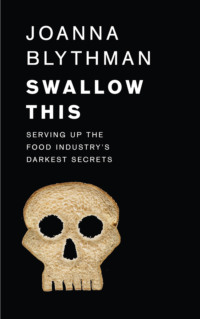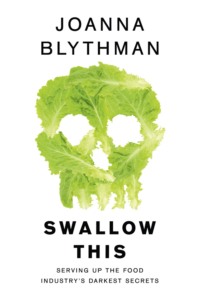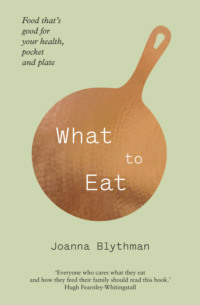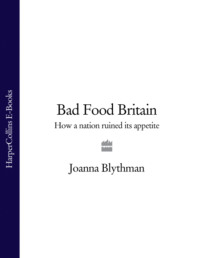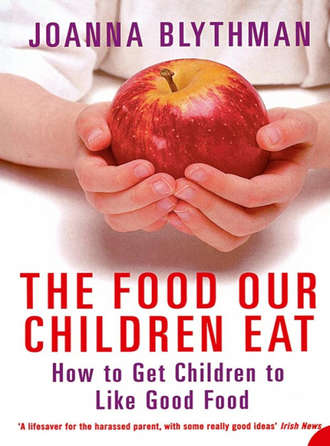
Полная версия
The Food Our Children Eat: How to Get Children to Like Good Food
That is why it is best to strike these bag snacks off your routine shopping list and turn instead to Twenty-five Good Snacks (pages 237–8), which lists alternatives that appeal to many children. For alternative packed lunch ideas, see Ten Good Packed Lunches (pages 259–62)
THE FLICKERING SCREEN
We are tired, the children are crotchety and we need to get on with some essential tasks, so we switch on the television to give us some breathing space. But as we buy ourselves some peace and relative quiet we may, without knowing it, be storing up problems when it comes to getting our children to eat a decent, wholesome diet.
We may begin to find that, even from the youngest age, when we try to give them water the children start demanding a sweetened fizzy drink. No matter how tempting the contents of our fruit bowl, we may see them gravitating towards the biscuit tin or demanding money to visit the sweet shop. We find ourselves wondering why they won’t eat anything made with fish, unless it’s coated in crispy crumb or formed into a special marine ‘shape’. When we buy the more traditional, unsticky breakfast cereals, we find them campaigning for the latest brand that’s stuck together with sugar and other sweet ingredients. Where do these demands come from?
Before you subscribe to the prevalent attitude that all children just naturally and spontaneously want to eat junk, consider first the pressure that emanates from that flickering screen. We need look no further than the diet of food ads served up on children’s prime-time television, which consists of little more than what some researchers call ‘an onslaught of junk-food hype’.
In 1996 the independent watchdog, Consumers International, surveyed the type of food advertising during peak children’s television hours in thirteen countries: eleven in Europe plus the USA and Australia. In the UK it found that children see seventeen adverts each hour and ten of these are for food or drink – the highest number of food and drink ads in any European country.
A massive 95 per cent of these ads were for unhealthy foods, high in fat, sugar or salt. Top of the food ad pops in the UK came confectionery, with breakfast cereals following a close second. By comparison, ads for foods that most people would agree should be encouraged, such as fruit and vegetables, were almost non-existent. The only remotely healthy ads that British children are likely to see on television are for frozen peas.
Consumers International’s survey confirms the findings of another carried out in 1995 by the National Food Alliance. This also concluded that advertising during programmes appealing to children presented a grossly unbalanced nutritional message with fatty and sugary foods predominating.
This imbalance matters particularly because children are less able than adults to understand the intent of advertising or its persuasive techniques and are therefore less able to treat it with scepticism. The younger the child, the more vulnerable she or he is to swallowing an advertising message uncritically. A 1996 UK government report reiterated what other researchers have found – that children have difficulty distinguishing television advertisements from the programmes surrounding them. At the most television-dependent age of three to four, when it is a boon to plonk down your offspring in front of the television while you get on with other things, it is unlikely that they can differentiate between the two. It is now thought that it is only after the age of ten to twelve that children realise that the purpose of advertisements is to persuade you to buy things. This confusion is compounded by the use of characters or personalities popular with children which appear to endorse the product in the child’s eyes. Whether it’s cuddly, collectable free gifts with characters from the latest cartoon blockbuster or a cute little familiar face on that pot of fromage frais, such images exploit children’s gullibility.
Obviously advertising isn’t the only message that influences what children eat. The advertising industry says that its critics ignore the role of families and education in helping children make healthy choices. When that familiar ‘Can we buy that?’ plea follows the ad, the advertising industry expects us to take the time to explain patiently to our children how that sticky cereal or fatty snack isn’t very healthy unless it’s part of a ‘balanced diet’. And surely public health campaigns and education at school should be pointing the nation’s youth along the right path too?
But there is a lot of research to suggest that television advertising is the single most important factor influencing what children eat. In the US researchers have found that even when allowing for factors such as sex, reading level, ethnic background, parents’ occupation and educational level, television viewing correlated with bad eating habits and faulty understanding of the principles of nutrition.
In Sweden and Norway the pressure has been taken off parents because no advertisements at all are allowed during children’s programmes. In Denmark and Finland sponsorship of children’s television isn’t allowed either.
In the UK, however, there are no such restrictions on advertising directed at children. So unless parents try actively to correct distorted perceptions, the junk-food message from television ads will constantly undermine our effort to get our children to eat well.
How can we react to this? There’s always the off switch, of course, but it takes a resolute spirit to keep children away from the box. More realistically, we need to recognise that children will pick up a junk-food message when watching television and that if we do nothing we are simply letting that process run its course.
On the other hand, we can decide that we are going to combat it with counter-propaganda for a wider and more wholesome range of food consistent with the real-food approach outlined in pages 55–60. This involves instilling cynicism about the taste, quality and long-term effects of eating junk and a certain determination that we aren’t going to give in to the predictable demands generated by advertising.
If you want some effective strategies for doing this, turn to Getting the Message Across on pages 61–6 and The Fun and Skill of Food Shopping on pages 221–4. For ideas about how to deal with pestering demands for junk directly, see Sweets, Treats and Bans on pages 91–5.
GIFT-WRAPPED JUNK
Having difficulty getting your child to eat? Never fear, the processed food industry’s marketing team is here to help. It has devised some super products, designed to be snapped up by the nation’s kiddies and make shopping easy for poor old driven-to-distraction ‘Mum’. Lest she should miss these on her desperate dash round the supermarket, many chains now have helpful signs such as ‘Children’s Desserts’ on those prominent end-of-aisle locations to make them stand out.
Not that these tailor-made products for kids are easy to ignore, either for ‘Mum’ or for her arm-tugging companions. They sing out with brightly coloured images of jolly cartoon characters or the latest collectable toy. And because these familiar images intrigue children – after all they see them over and over again on children’s TV – trying to take a toddler or small child past them without being put under pressure to buy is about as easy as convincing them to walk past a playpark without going in.
The packaging that the images adorn is a triumph of technical wizardry. Anything straightforward is out – after all, we all know that kids have to be bribed into eating food, don’t we? So packaging takes over and generates an endless stream of novelties designed to capture that gullible junior market.
The straightforward old yogurt pot, for example, is out. Now yogurt must come in rigid two-compartment plastic containers with a dinky-doo addition to mix in. Anything goes, from multi-coloured sprinkles to chocolate polka dots or crunchy mini-biscuits – with the caveat that it must be sweet.
If two compartments already seem old hat, then bored children can be further tempted by that little fromage frais that comes with its own toy or handy little spoon. Worried about the environmental impact of all this moulded plastic? Then plump for that reusable container which can be broken down and then remodelled into a constructable toy.
Finding those rolls and sandwiches coming home uneaten in the lunch box? Why not give the kids a miniaturized box so that they can have the fun of assembling their own lunch, sandwiching processed ham and cheese with salty crackers as perfectly as any dovetail joint?
Cheese getting the thumbs-down? What about letting them make their own self-service selection of pick ’n’ mix miniaturised cheeses or trying them out with a runny cheese and dipping biscuits ensemble?
All right, no one these days seriously expects children to eat a bit of whole fish anyway, but what do you do if they begin to reject even fish fingers? Try out fishy shapes with special tails for them to hold as they dip them into that essential ketchup, of course. Dinosaur-shaped Kievs, reconstituted potato with cute little arms and legs or funny faces, condensed milk, fromage frais or yogurt drinks in squeezy tubes to suck at playtime, triangular milk shakes, mini cup cakes topped with a rice-paper image of their favourite cuddly character … so continues the litany of food products targeted at children.
You have to give these products credit for being both ingenious and inventive – as far as food manufacturers are concerned, that is. This endlessly novel repertoire of ‘children’s’ specialities allows them to take heavily processed junk food, gift-wrap it in images guaranteed to appeal to children, then sell it at a tidy profit.
There’s a limit, of course, to how much they can charge for a basic frozen potato shape, fish finger, fromage frais or processed cheese. But once they have succeeded in packaging it for children they can simply sit back and listen to those cash registers ringing. There’s nothing wrong with profits, of course, and manufacturers insist that they are only giving parents a helping hand. What despairing parent with an infamous ‘picky child’ would not be prepared to pay that little premium if these products get him or her to eat something he or she would not otherwise? But the price parents and children pay is quite high if we consider the quality of the food on offer. Real potatoes don’t have arms and legs – to give them these, they need to be moulded together with chemical additives. Cheese doesn’t squirt naturally – a range of chemical emulsifiers and cheap dairy by-products needs to be incorporated first. It seems that the food industry has ordained that all those yogurts and fromage frais prominently featuring images of the latest desirable ‘collectable’ just have to have chemical preservatives and flavourings. In order to process that ham into its easy-to-handle shape, it has to have lots of added water, polyphosphates and the standard flavour enhancers. Not to put too fine a point on it, if we wanted to home in on products stiff with chemical additives, then we need look no further than these gimmicky offerings.
Most of us know that when we buy these children’s novelties we are paying over the odds for something that isn’t that healthy. But we feel desperate. Better they eat something than nothing, we think. And as far back as any of us can remember, there’s been a deep-seated belief that by taking basic ingredients and repackaging them in forms that appeal to children, we can get them to eat what they might otherwise reject.
But is presentation really the best long-term tool to get children to eat? Does every food we offer them have to be disguised with amusing little ears or sugary sprinkles? If you have your doubts and would rather your children ate real food, not gift-wrapped junk, then turn to pages 86–90, Presentation, Boredom and the ‘Yuck’ Reaction, for ideas.
GOODBYE DINNER LADY, HELLO CASH CAFETERIA
From time to time we hear about a school that serves healthy lunches to its children, or another that has taken the huge step of banning sweets and crisps as snacks at break, asking pupils to bring fruit instead. Such schools generate media attention because they are so rare. The overwhelming bulk of food on offer from school catering services is over-processed, low-grade stuff from which it is almost impossible to make a wholesome selection even supposing you were an adult nutritionist, let alone a confused seven-year-old, trying to see through the queue ahead, all the time concentrating on holding your tray and not dropping your money.
Traditionally school meals have never been gastronomic experiences, but at least in the past each school employed its own cook and a good part of the food was real and unprocessed, however limited in range. Water was the standard drink. Nowadays the dinner ladies and cooks of the past have mainly been made redundant and the dinner hall has been replaced with a vastly reduced staff operating the ‘cash cafeteria’. Their task consists of reheating or assembling a specified number of portions of ready-prepared items, targeted at what the food industry euphemistically calls ‘young consumers’, for which a more candid description might be ‘consumers of junk’.
This is a consequence of the 1980 abolition of any nutritional standards for school meals and the introduction of a policy called ‘Compulsory Competitive Tendering’ (CCT), which was widely implemented in the 1980s. It obliged local authorities to choose the most ‘competitive’ (for which read cheap) catering on offer. In-house, labour-intensive school meals were widely axed in favour of cheaper, large-scale outside catering operations. Those that were retained had to match the lowest commercial tender.
Later in the 1980s, cuts in entitlement to free school meals reinforced the damage done by CCT. Fewer children qualified for free meals and this reduced the total demand. Less uptake means fewer economies of scale and makes it even harder to provide wholesome meals on a low budget. While in 1979 some 64 per cent of children ate school meals, by 1996 that figure had dropped to 43 per cent.
The end result is that there is basically no real cooking going on in the vast majority of schools. On the hot front, bought-in, ready-prepared Kievs, pizzas, even baked potatoes are simply reheated. Burgers and sausages are cooked briefly. Everything is ‘portion-controlled’ to eliminate waste and must consist of a single or small number of units of food which can be stored for some time, preferably frozen. Even the apparently healthy and wholesome option of soup is characteristically straight out of the packet – just add water.
In certain areas, local authorities are trying to make school meals more profitable by converting cafeterias into ‘food courts’ which ape fast-food chains. The usual burgers, pizzas and fizzy drinks are served from US-style food counters with illuminated displays of the food on offer – just like high-street chains – by staff wearing baseball caps. These ‘initiatives’ are sponsored by manufacturers of junk food and fizzy drinks whose corporate logos are emblazoned over the eating area, on polystyrene plates and cups and on staff uniforms. This trend means that children get no respite from junk-food advertising even at school.
Other schools now have no hot food whatsoever, a consequence of further local authority budget cuts. They tend to serve only the very worst sort of mass-produced sandwich which even makes its petrol-station forecourt equivalent seem gourmet. Many schools have been told to offer salads because nutritionists advocate these as a healthy choice. Once again, a child will be lucky to see a simple sliced tomato, cucumber disc, carrot baton or lettuce leaf. Instead, it’s plastic tubs filled with bought-in offerings, conspicuously short on vegetables and instead loaded up with starchy, stodgy offerings of rice, corn, pasta, pulses or egg, all slathered in commercial dressings.
Healthy-eating guidelines abound and school catering services can all offer chapter and verse on how they are doing their bit in this regard. But these guidelines are applied within the limits of mass-catering processed foods; they rarely mean that children are given more fresh fruit and vegetables or more wholesome basic ingredients. On the contrary, the most tangible manifestation of healthy-eating guidelines is an increased presence of highly processed items in the form of ‘low-fat’, ‘lite’ and ‘diet’ foods and drinks.
There are different justifications offered for the ‘healthiness’ of these items depending on what they are. The first is that they use margarine or vegetable fat instead of butter or lard. Yet some scientists believe that the trans-fats in the former may be at least as unhealthy as the saturates in the latter. The second is the substitution of skimmed milk for whole milk. However, although it has less fat, experts do not agree over whether skimmed milk is better for children. The third is the substitution of artificial sweeteners for sugar. Sweeteners do contain fewer calories than sugar, but many scientists have reservations over the safety of the former and whether or not they actually result in lower sugar consumption.
So the jury is still out on all these issues. But the current net effect of well-intentioned ‘healthy-eating’ guidelines in schools is that children are eating more heavily processed, technologically altered foods than before, foods that have not been tried and tested over time and whose long-term effect on human health is not yet known.
Processed techno-foods fit in very well with the economics of modern school catering, which boils down to running a cheap, lowest-common-denominator service with as little waste as possible. There is absolutely no slack for experimenting with more natural and nourishing foods which might require more labour, some food education and scope for experimentation.
In fact the prevailing budget pressures on school caterers – whether they are privatised or public sector – mean that they cannot afford to take any risk at all and so instead it’s now customary to major on the sure-fire ‘children’s foods’ such as crisps, fizzy drinks and confectionery because these are guaranteed to sell. These items have a long shelf life too. No surprise, then, when the typical statutory school cafeteria fruit bowl – generally full of the dullest fruits around, such as mealy-textured, bruised apples, shrunken oranges, bright green or wizened black bananas – has few takers.
Children aren’t always very good at describing school food. Here’s a taste of some of the delightful dishes commonly on offer.
A menu of modern school meals classics
For main course:
TURKEY/CHICKEN KIEVS/NUGGETS, SPAGHETTI AND POTATO SHAPES
(Cheap, processed, intensively reared meat in fatty fried crumb coating; sweet, stodgy tinned spaghetti; reconstituted dried potato and additives in fatty coating)
HOT DOG ROLL/SAUSAGE ROLL, BEANS AND POTATO SHAPES
(More cheapest of the cheap meat full of additives and water, stuck in a pappy, over-refined white roll or coated with artery-clogging, fat-laden pastry, with sweet and salty beans, plus spuds as above for added stodge)
VEGETABLE CURRY, MIXED VEG AND RICE
(This more promising-sounding vegetarian alternative consists of frozen ready-cut vegetables defrosted in sweet, starch-thickened catering curry sauce with waterlogged frozen vegetable ‘macedoine’ and gluey white rice)
CHEESE AND BACON/BROCCOLl/SWEETCORN FLAN, TURNIP, POTATOES
(Rubbery Cheddar, miscellaneous ‘savoury’ ingredients and reconstituted dried egg in a greasy layer of under-cooked pastry, with boiled diced turnip – about the cheapest frozen vegetable that can be bought in and about the least likely to appeal to children – with a scoop of rehydrated ‘mashed’ potatoes)
SAVOURY PASTIE, PEAS, CHIPS
(An unidentifiable-by-ingredient mulch combining processed meat such as corned beef or starchy potatoes with industrial fillers and flavourings, encased in lardy pastry; watery peas and reheated chips)
MEAT CASSEROLE, CABBAGE, POTATO
(A small amount of meat, often sausage, in thickened starchy sauce with frozen vegetables; boiled-to-death cabbage and the regulation scoop of rehydrated mash)
ROAST MEAT AND POTATOES, SPROUTS
(Pre-cooked, thinly sliced meat reheated in catering brown sauce, ready-cooked roasted potatoes and sulphurous, over-cooked sprouts)
‘HOME-MADE PIZZA’
(Thin slices of ready-made catering dough topped with watered-down tomato paste and rubbery Cheddar, then baked)
BATTERED FISH WITH TOMATO
(A small amount of desirable white fish dwarfed by its fatty batter, served with unadorned tinned tomatoes)
For pudding:
JELLY WHIP
(Shuddery synthetic dessert containing a litany of additives and no real anything else apart from generous amounts of sugar and gelatine)
DOUGHNUT AND CUSTARD
(Deep-fried, sugary stodge lubricated with extra sugar, colourings and flavourings, plus sugary, additive-laden ‘custard’, usually from a just-add-water mix)
CHOCOLATE CRISPIE/ICED SPONGE/CARAMEL FLAN/FLAPJACK/GINGERBREAD AND CUSTARD
(As above, minus the frying)
SEMOLINA AND FRUIT
(Lumpy milk pudding which rarely appeals to children, even in its unlumpy form, served with sweetened tinned fruit)
‘HOME BAKING’
(Cup cakes and tray bakes which are heavy on sugar, margarine and refined white flour)
To drink:
CARTONS OF FRUIT SQUASH AND ‘DRINK’/ BLACKCURRANT DRINK/COLA/CARBONATED ORANGE
(A heavy-handed serving of sugar topped up with water and additives)
HOT CHOCOLATE/MILK SHAKE
(Sugar, milk powder, flavourings and thickeners mixed up with water)
It’s no wonder that many children loathe school meals and abandon them at the first possible opportunity. But what about other school food?
School tuck shops have not served anything other than sweets, crisps and fizz since time immemorial. Nothing has changed in that department, except perhaps for the arrival of grain-based biscuits which purport to be healthy but whose heavy-handed sugar composition gives the lie to that.
What is new, however, is the arrival of snack and drink vending machines in schools. Filled exclusively with everything that is the antithesis of wholesome eating, these machines are becoming a common feature in many secondary and even some primary schools. Most teachers disapprove of them, but when a school is strapped for cash the income they offer can be tempting.
Looking at a secondary school in Merseyside in 1998, the Guardian reported that the profit to the school from its eight vending machines was forecast at £15,000 a year. Revenue on this scale can keep a music department in musical instruments or buy a much needed piece of equipment. But this system also handicaps the more wholesome alternative. In many schools nowadays, the only place a child can get a free and straightforward drink of tap water is in the washrooms!
School food has got so bad that it looks as if the government will reintroduce nutritional standards at least for school meals, if not for tuck shops. It remains to be seen how effective these will be in tackling the unhealthy monster that school meals have become.




